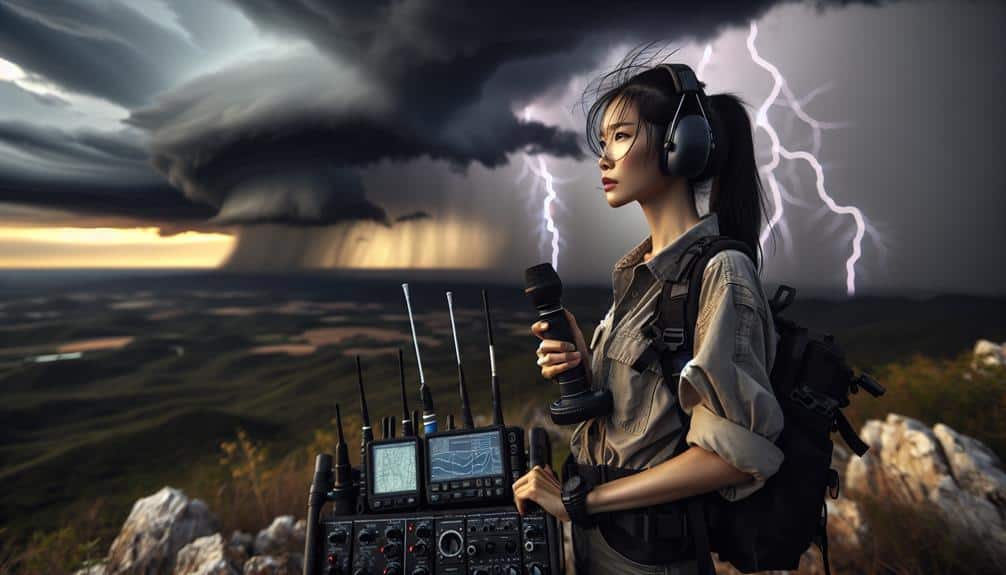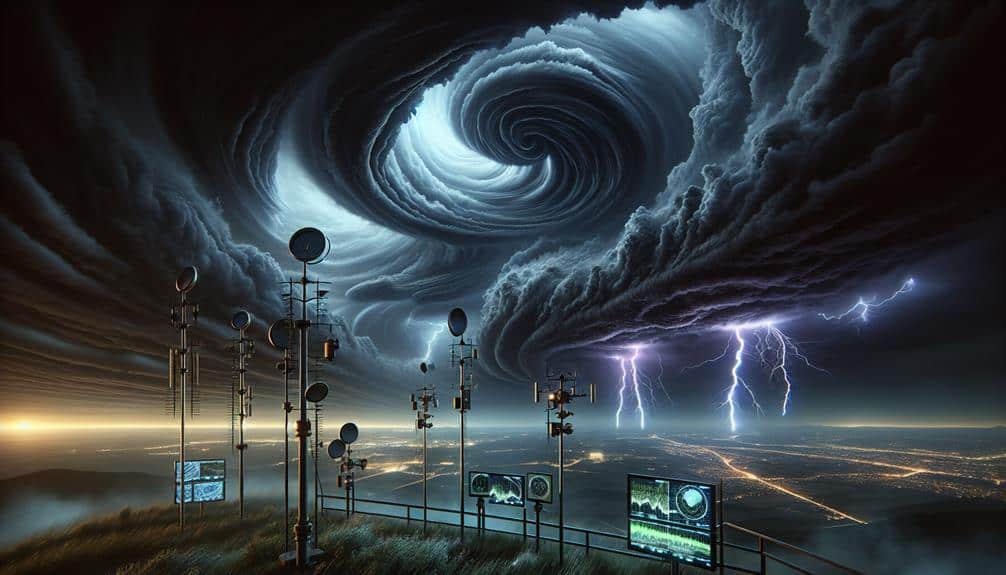As storm chasers, we predict storm formations by scrutinizing atmospheric data and employing radar technology. We analyze variables like humidity, temperature gradients, and wind shear, then overlay historical climate data for recurring patterns. Utilizing advanced Doppler radar, we detect mesocyclones and rotational features with high precision. We also examine cloud morphology, particularly cumulonimbus formations, for indications of severe weather. Real-time field observations with precise instruments help us monitor atmospheric conditions dynamically. If we keep these techniques in focus, we enhance our predictive capabilities greatly, and there are further insights to be explored.
Key Points
- Monitor temperature gradients and humidity levels to identify potential storm development.
- Utilize Doppler radar to detect mesocyclones and rotational features in thunderstorms.
- Analyze atmospheric pressure fluctuations to spot emerging low-pressure systems.
- Observe cloud formations, especially cumulonimbus, for signs of severe weather.
Understanding Weather Patterns
By analyzing atmospheric data and patterns, we can identify the key indicators that precede storm formations. Delving into weather dynamics and meteorology studies allows us to pinpoint the exact variables that signal potential storm development. We focus on parameters like humidity levels, temperature gradients, and wind shear, which are vital in forming predictive models.
Climate patterns play a significant role in storm predictions. By examining historical climate data, we can detect recurring atmospheric phenomena that often lead to storm activity. For instance, the presence of a low-pressure system combined with high atmospheric instability typically marks the beginning stages of storm formation. These insights are backed by robust data analytics and statistical correlations derived from extensive meteorological research.
Understanding these intricate weather dynamics is fundamental for storm chasers who crave the thrill of the chase while ensuring safety. We can't overlook the importance of real-time data collection, which refines our predictive accuracy.
As we interpret these complex climatic signals, our ability to predict storms becomes increasingly precise, empowering us with the freedom to make informed decisions on when and where to set off on our next storm-chasing adventure. This analytical approach maximizes our chances of encountering storm phenomena while minimizing risks.
Utilizing Radar Technology
Leveraging our understanding of weather patterns, we now turn to radar technology to enhance our storm prediction capabilities. Radar accuracy is paramount for effective storm tracking, allowing us to pinpoint the location and intensity of developing weather systems. Utilizing state-of-the-art Doppler technology, we can analyze the velocity of precipitation particles, providing critical insights into the storm's movement and potential growth.
By examining Doppler radar data, we can predict precipitation with remarkable precision. This technology measures the phase shift of returned radar waves, enabling us to determine the speed and direction of raindrops and hailstones. Such detailed information is invaluable for anticipating severe weather events, giving us a tactical advantage in the field.
Furthermore, high-resolution radar scans allow us to detect mesocyclones and other rotational features within thunderstorms. By closely monitoring these radar signatures, we can identify the precursors to tornado formation, enhancing our ability to forecast these dangerous phenomena.
In our pursuit of storm chasing, the integration of radar technology offers unparalleled freedom to track storms more accurately and make informed decisions. With the right tools and data, we can navigate the complexities of storm prediction and stay ahead of nature's most formidable forces.
Analyzing Atmospheric Data
Analyzing atmospheric data, we scrutinize variables such as temperature, humidity, wind speed, and pressure to gain predictive insights into storm development. Atmospheric pressure analysis is essential; it reveals high and low-pressure systems that can signal storm formation. We look for data correlations between decreasing pressure and increasing storm activity.
Temperature gradients provide another layer of insight. A steep temperature gradient often indicates the potential for severe weather. For instance, when warm, moist air collides with cooler, dry air, the instability can lead to storm formation. Tracking these gradients helps us identify areas of concern.
Wind speed fluctuations are equally significant. Sharp changes in wind speed and direction, known as wind shear, can indicate the development of severe thunderstorms or even tornadoes. We continuously monitor these variations to assess the risk and intensity of impending storms.
Humidity levels, too, play a crucial role. Elevated humidity can enhance the energy available for storm systems. By analyzing these atmospheric parameters in conjunction, we create a detailed picture of storm potential. This thorough approach empowers us to make informed predictions, giving us the freedom to chase storms with both excitement and caution.
Interpreting Cloud Formations
When we interpret cloud formations, we meticulously examine the morphology, altitude, and movement of clouds to anticipate storm development. By dissecting cloud identification, we can pinpoint specific formations such as cumulonimbus, which are pivotal in storm prediction. Observing these towering clouds, often exceeding altitudes of 20,000 feet, indicates potent vertical updrafts and severe weather potential.
In storm chasing, combining cloud identification with weather photography offers dual advantages: visual documentation and real-time analysis. Capturing supercell structures, shelf clouds, or anvil tops in high-resolution imagery aids in evaluating storm severity and trajectory. Additionally, analyzing cloud movement—whether they're advancing, dissipating, or rotating—provides critical data for predicting storm evolution.
We utilize tools like satellite imagery and Doppler radar to verify our visual evaluations, ensuring our storm prediction is data-driven. For example, a rapidly developing cumulus congestus can denote imminent thunderstorms, whereas a decaying cumulonimbus might signal storm dissipation.
Real-time Field Observations

In real-time field observations, we carefully monitor atmospheric conditions, including wind speed, temperature, and humidity, to refine our storm predictions. Using advanced weather instruments like anemometers, hygrometers, and barometers, we capture vital data to analyze storm behavior in its early stages. These instruments provide us with precise measurements, enabling a data-driven approach to storm chasing.
As storm chasers, our primary goal is to predict and track severe weather phenomena with accuracy. By continuously updating our readings, we can identify changes in atmospheric pressure and wind patterns that often precede storm formations. This real-time data collection is essential for making split-second decisions on the field.
For example, a sudden drop in barometric pressure or a rapid increase in wind speed can indicate an imminent thunderstorm or tornado development.
Safety precautions are paramount during these expeditions. We always make sure our vehicles are equipped with essential safety gear, including first-aid kits and emergency communication devices. Additionally, we follow strict protocols to maintain a safe distance from the storm's core, balancing the thrill of storm chasing with the necessity of staying out of harm's way.
Through careful real-time field observations, we enhance our understanding and predictive capabilities, thereby pushing the boundaries of meteorological science.
Frequently Asked Questions
How Do I Stay Safe While Storm Chasing?
We've found that rigorous safety precautions are essential. Our data shows that detailed emergency plans greatly reduce risk. By adopting these strategies, we maintain our freedom to chase storms while minimizing potential hazards. Let's stay informed and prepared.
What Equipment Is Essential for Storm Chasing?
When considering essential storm chasing equipment, we prioritize weather radar for real-time data and emergency kits for safety. Advanced radar systems enhance our situational awareness, while emergency kits guarantee we're prepared for unexpected situations, safeguarding our freedom to chase safely.
How Do I Join a Storm Chasing Community or Group?
Joining a storm chasing community involves understanding the joining process and requirements. Networking opportunities provide substantial benefits, including access to real-time data and advanced forecasting tools. We should leverage these resources to enhance our storm chasing capabilities and freedom.
What Legal Considerations Should I Be Aware Of?
We should consider legal restrictions, obtain necessary permits, and adhere to safety precautions. Data indicates that compliance with these regulations minimizes risks and maximizes our freedom to chase storms effectively and responsibly.
Ah, the noble art of storm chasing! We document our escapades with high-resolution imagery and precise data logs. For storytelling, we use social media and blogging platforms. Sharing experiences digitally guarantees our tales of tempestuous freedom reach the masses.


